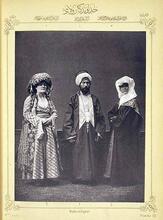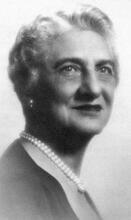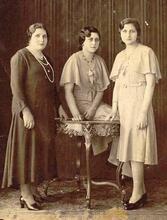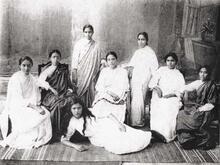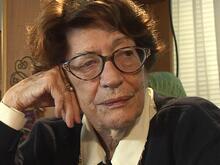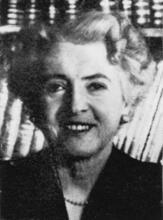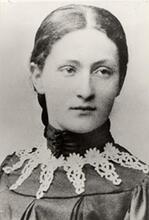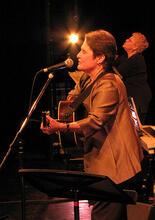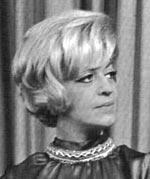Jewish Women in New Zealand
The Jewish community in New Zealand may be small but, throughout its history in the country, members of the community have punched well above their weight. This trend is evident in the achievements of Jewish women, many of whom have enjoyed prominent careers in their chosen areas. In fact, they account for a significant number of “historic firsts” in various fields – including the country’s first woman lawyer and first woman doctor. This entry surveys some of the remarkable Jewish “Kiwi” women who have contributed to New Zealand life across a wide range of disciplines, from art to politics to music to business.
People in America and Europe have expressed surprise that there are any Jews at all in New Zealand, a small country in the far South Pacific. Yet Jews started migrating to New Zealand early on in its colonial history. The first Jewish traders arrived in 1829, a decade before the signing of the country’s founding document, the Treaty of Waitangi (1840). Women were among the earliest Jewish settlers, and the first Jew born in New Zealand was a female, Sarah Nathan, in 1843. Her sister was the first buried, a year later. Both were children of David Nathan and Rosetta Aarons, the first Jewish couple to marry in the colony in 1841.
By 1900, small Jewish communities had formed in the main centers and religious and social institutions had been established. Jewish women were actively involved in these communities from early settlement days on. However, New Zealand’s “official” (census) Jewish population has remained a small one, reaching 6,000 only at the end of the twentieth century and standing at about 8,000 as of 2019. It has never constituted more than about 0.2% of the country’s population, which is now 4.9 million.
Despite their small numbers, Jewish people have “punched well above their weight” and made numerous significant contributions to New Zealand society. This trend is also evident in the achievements of Jewish women, many of whom have enjoyed prominent careers in their chosen areas. Jewish women account for a remarkable number of “historic firsts” in various fields. The first woman doctor and woman lawyer in New Zealand were both Jewish, for example.
Medical practitioners
New Zealand Jewish women have been notable pioneers in several professional fields, especially medicine. Born in Dunedin, Emily Siedeberg (1873-1968) was encouraged by her father to study medicine at Otago University College in 1891. Although women’s right to study at the medical school had been established, she still had to battle persistent hostility from male students and lecturers during her five years of training. Despite this, Seideberg earned a Bachelor of Medicine and Bachelor of Surgery in 1896, followed by post-graduate work in Europe. In 1898 she went into private practice in Dunedin, becoming the first woman to do so in New Zealand. Around 1905 Seideberg became St Helens Hospital’s first medical superintendent and set up New Zealand’s first antenatal clinic. She was a founding member of the Plunket Society and its president from 1933 to 1948. In 1921, she helped found the New Zealand Medical Women’s Association and served as its first president. Over the course of her long life, she received many honours, including a CBE (Commander of the Order of the British Empire).
Another early medical practitioner was Augusta Manoy (1898-1989), who arrived in New Zealand in 1910 from Latvia. She received her degree in medicine from Otago University College in 1926 and then completed graduate studies in pediatrics in London and Vienna. Her medical career was cut short after she married and moved to Sydney. Manoy returned to Auckland in 1934 and became the Auckland branch treasurer (1939-1946) and president (1954-1956) of the New Zealand Women’s Medical Association. She also helped to establish the Jewish Women’s Refugee Committee. Influential in her own right, she also left another type of legacy: her son-in-law and two of her grandsons became prominent in the medical field.
Few Jewish women followed in the wake of these pioneers until Nazism and World War II prompted an influx of Jewish refugees from Europe, including female medical practitioners. For example, Selma Hahn (died 1988) practiced medicine in Prague until the German occupation, after which she served as a nurse. A survivor of the Holocaust, she worked with the United Nations Relief and Rehabilitation Administration after the war. On reaching New Zealand in the early 1950s, she re-qualified with a medical degree from the University of Otago and then ran a general practice in Auckland for many years.
Another refugee from Czechoslovakia was Minsk-born Rachel Monk (née Benarov, 1907-1994). She too had to retrain in Dunedin. Later, she worked as a general practitioner, mainly in Auckland. Early in her career she ran clinics, when others would not, for the Maori princess Te Puea at Turangawaewae. For this, she earned life-long respect and mana (high esteem, prestige, and authority) among Maori.
Czech-born Ruth Black (neé Blumenthal, 1925-2017) was a pioneer in the field of family planning, founding and chairing the New Zealand Family Planning Council in 1963–1964. She represented New Zealand on the International Planned Parenthood Federation of Southeast Asia and Oceania. Black also served on the boards of the Broadcasting Corporation and TV2.
Psychologist Grete Christeller (1895-1964) trained in Zurich and became a member of the London Society of Analytical Psychologists in 1949. On migrating to New Zealand, she practiced in all the main cities before settling in Christchurch. She was one of the founders of the New Zealand Association of Psychotherapy, and her larger-than-life personality left a lasting impact on the profession.
Legal minds
A Jewish woman was also a trailblazer in law. Ethel Benjamin (1875-1943) was New Zealand’s first female law graduate and practicing lawyer. Like Seideberg, Benjamin hailed from Dunedin and studied at Otago University College. Entering the law school in 1893, she had to overcome many hurdles to gain her degree, but she graduated in 1897 and was admitted to the Supreme Court of New Zealand as a barrister and solicitor.
Benjamin faced persistent opposition from within the legal profession. Although she established a reasonably successful legal practice, with the support of the Jewish community and female clients, it proved a struggle, prompting her to embark on another career as a businesswoman, mainly in the hospitality industry. After marrying in 1907, she returned to the law, first in Wellington, and then, after a move to England in 1910, in London. Faced with further obstacles, she switched careers again, this time to banking. She also worked in a law firm but could not practice law fully until the Sex Disqualification (Removal) Act was passed in 1919. She lived in France and Italy between the wars but later worked as a lawyer in London before her death.
Benjamin was a rarity in the legal world. The next New Zealand woman to gain a law degree did not do so until 1911; even after World War II, the number of women entering the law was small. Not until the 1970s did the situation begin to change. Now, however, many women work in law, including several well-known Jewish ones.
Ruth Busch, for instance, trained in America and worked in Canada. She taught at the Waikato University Law School from 1988 until the 2000s. She was active in promoting law reform in the area of domestic violence, women and the law, and family law, including custody and access.
Sylvia Bell (nee Mandl), the daughter of Czech refugees, gained her law degree from the University of Auckland in 1984 and has focused on human rights work throughout her career. She has led legal teams at the Mental Health Foundation, the Human Rights Commission, and the Office of the Race Relations Conciliator and is currently at the University of Auckland’s law school. She is also the author of authoritative books on mental health and human rights law.
The current spokesperson for the New Zealand Jewish Council, Juliet Moses, is also a lawyer. Moses graduated from the University of Auckland law school and was admitted to the bar in 1996. A partner at TGT Legal, her specialty areas include trust law, superannuation, and relationship property issues.
Civic figures
As the first country in the world to give women the vote, in 1893, New Zealand holds tightly to its reputation for women holding positions of political power. Indeed, Prime Minister Jacinda Ardern, elected in 2017, is the country’s third woman in the role. There have also been three women Governor Generals and two women Chief Justices.
Yet few women have become prominent political leaders, reflected in the fact that very few Jewish women have risen to high levels in national and local body politics. Just two female MPs have had Jewish ancestry.
Whetu Tirakatene-Sullivan (1932-2011), a prominent Labour MP and sometime Cabinet Minister, had Jewish forbears on her mother’s (née Solomon) side. A social worker and academic before entering Parliament in 1967, Terakatene-Sullivan was a necessary advocate for Maori interests for the next 30 years. She is New Zealand’s longest serving female MP.
Winnie Laban (born 1955) is well known as New Zealand’s first female Pacific Island MP, but Laban has described herself as “made in Samoa, born in New Zealand, and with Samoan, European, and Jewish ancestors.” While she does not identify herself as Jewish today, her Jewish background is clearly important to her. Originally a community development worker, she was a Labour Party MP from 1999 to 2010, during which she also served several years as Minister of Pacific Island Affairs. After leaving Parliament, she became assistant Vice-Chancellor at Victoria University of Wellington. In 2018, she was made a Dame for services to education and the Pacific community.
In local government, a notable figure was Dame Barbara Goodman (1932-2013), who was involved in the governance of New Zealand’s largest city, Auckland, for several decades. During the 1970s, she served as mayoress (a ceremonial role for a partner or female relative of a major) for her uncle, Sir Dove-Myer Robinson, one of the city’s longest serving and most colourful mayors. Her husband, Harold Goodman, became deputy mayor of Auckland City in the late 1970s; following his death, Barbara was elected to Auckland City Council in 1988 and spent twelve years as a city councillor. Goodman was well known for her support of a range of social causes, including gay rights. For ten years, she was also the chairwoman of Odyssey House Auckland, which provides rehabilitation services for those struggling with addiction. In 1988 she was made a Dame for services to community welfare and rehabilitation.
Another prominent local politician was Eva Poole (1924-1992), who was the first female mayor of Invercargill, New Zealand’s southernmost city. Born in Germany, she fled Nazism with her family in the early 1930s. They settled in British Mandate Palestine (now Israel), where she met her husband, a New Zealander, during World War II. After the war, Poole and her husband moved to Invercargill. Having trained at Habima Theatre in Tel Aviv, she became a drama teacher. In 1971, she was elected to the Invercargill City Council and became deputy mayor in 1974. In 1983, she successfully ran for mayor and remained in the post until her death. She was particularly active in arts patronage.
Several women have been outstanding community leaders. Dame Grace Hollander (1922-2016), born in Christchurch to post-World War I Jewish migrants from the United Kingdom, became known for her work with a wide range of voluntary community organizations. As a sample: she was treasurer and president of the National Council of Women, the first woman president of the New Zealand Federation of Ethnic Councils, and president of the New Zealand Council of Jewish Women. She was president of the Canterbury Hebrew Congregation in the early 2000s and served as a Justice of the Peace for many years. In 2000, she was made a Dame for services to the community.
Also known for her civic activities was Simone Nathan (born 1888), president of WIZO for over thirty years, an active member of Hadassah, one of the first members of the Plunket Society (an organization that provides a range of free services to improve the health, development, and wellbeing of children under five), and a fundraiser extraordinaire. Originally from Glasgow, Doris Lewis (born 1928) served the Wellington community for over 40 years after emigrating in 1956. She was the first woman member of the Wellington Hebrew Congregation’s board of management in the early 1990s. She later became the first woman on the Wellington Jewish Community Centre’s management council.
Irish-born Ruth Gotlieb (1923-2019) had a long, distinguished career in local government, including 27 years on the Wellington City Council, the Wellington Regional Council, the Wellington Harbour Board, and the Capital & Coast District Health Board. Awarded the QSO (Queens Service Order) for public service in 1995, she was named Wellingtonian of the Year for 2010-11. Inge Woolf, a child survivor of the Holocaust, arrived in New Zealand in the 1950s. Best known as the founding director of the Holocaust Centre of New Zealand, she also served as president of the Wellington branch of Zonta, which advocates for women.
Business notables
Although several of New Zealand’s most successful businessmen and business dynasties have been Jewish, few women have featured prominently in the commercial realm. Interestingly, of the few who have, their business contributions have often gained public attention due to their philanthropy.
Annie Deckston, a pioneering businesswoman and philanthropist, fits squarely into this tradition. With husband Max, Deckston arrived in Wellington from Poland in the 1890s with limited resources. They soon prospered from their work as farmers and fruit-shop owners and built their fortune through successful property investments. In 1932, they founded a home for Jewish orphans in Wellington. The proceeds from the sale of the original orphanage building were later used for a Jewish old age home, still known as the Deckston Home.
Ethel Berman was the first woman in New Zealand to earn a Bachelor of Commerce degree, in 1919, but little else is known about her. Lilly Bruell, a refugee from Germany, settled in Auckland with her husband. During the 1950s, she set up Playnit Ltd, a company that successfully produced fashionable women’s clothing and sportswear and exported it to Asian countries. The company was considered a model for employer-employee relations.
Raye Freedman (1909-2006) arrived in New Zealand from Canada in 1942 to marry her first husband. She became a successful businesswoman, operating a property development business, among various other ventures. Later, she was one of Auckland’s most generous benefactors and an active member of the Jewish community. With her second husband, she helped to establish Shalom Court, a Jewish rest home. In 2005, she founded a Jewish community library and helped fund the Raye Freedman Arts Centre at Epsom Girls Grammar School. The Raye Freedman Trust continues to offer arts scholarships to students at the school.
The 21st century has seen a new wave of successful Jewish businesswomen, including prominent restaurateurs, chefs, and cookbook writers Yael Shochat and Natalia Schamroth. Originally from Israel, Shochat has owned and operated various incarnations of her well-known restaurant, Ima Cuisine, for over 15 years. Schamroth has been co-owner of award-winning Auckland restaurant, The Engine Room, since 2006.
Sara Tetro (b.1969) is one of New Zealand’s top model agents, celebrity managers, and businesswomen. She runs three companies—62 Models & Talent, 62 Management, and The People Shop—and was also the host of New Zealand’s version of Next Top Model. The TV show, along with her second marriage to high profile businessman Rob Fyfe, has made Tetro a prominent figure. She is active on various charitable trust boards and her not-for profit directorships include the New Zealand Rugby Players’ Association, the North Shore Hospital Foundation, and the Springboard Trust.
Academics & Educators
Jewish women were among the first female graduates in the late nineteenth century. An early graduate was Nelson-born Phoebe Myers (1866-1947), whose brother, Sir Michael Myers, became the first Jewish Chief Justice of New Zealand. She earned a BA from Canterbury University College in 1890 and undertook further study at Victoria University College (Wellington) in the early twentieth century. While studying, she also worked as a University demonstrator in biology and taught at several Wellington secondary schools. She taught until 1921, but it was as an educational administrator and reformer, with a focus on girls and women, that she left an enduring legacy. In 1914, Myers helped establish the Federated New Zealand Women Teachers’ Association (NZWTA) and served as first its president and then its vice-president. She also represented women’s interests on the General Council of Education until 1920, promoted women’s rights through writing, and was a justice of the peace. In 1929, she represented New Zealand at the League of Nations, becoming the first woman to represent her country there.
Another early graduate was Agnes Hallenstein (1868-1953), who grew up in Dunedin and graduated with an MA from Otago University College in 1893. She then headed to Europe, where she spent the rest of her life as an art collector and traveller.
Following these early pioneers, there was a dearth of women academics until the 1960s, but since then there have been many Jewish women academics. For example, Gerda Eichbaum (later Bell, 1903-1992) came to New Zealand as a refugee from Nazism. Having completed her PhD in Art History in 1928, she become a German teacher at an Anglican boarding school in the late 1930s. After shifting to Wellington, Dr. Bell became a lecturer in Italian and German at Victoria University from the early 1960s on. A notable and astute arts writer, she also wrote the only major biography of Ernest Dieffenbach (1811-1855), the German physician and botanist and the first trained scientist to work in New Zealand. In 1986 she received the Officer’s Cross Ordination of Merit from the Federal Republic of Germany in recognition of her publications and research on German-New Zealand relations.
Originally from England, Prue Hyman (born 1943) is a feminist economist who taught at Victoria University for many years. She was assigned temporarily to work as an economist at the Ministry of Women’s Affairs in 1989-1990 and was Associate Professor of Economics and Women’s Studies from 1990 until 2010. Hyman worked widely as a consultant to government and other agencies. She has also written extensively on women and economics and has a particular concern with equal opportunities and the poorly paid. She is also an active member of Wellington’s Progressive congregation and is their convenor for social action.
Berlin-born Livia Kathe Wittmann (b.1938) established the Feminist Studies Department at Canterbury University. After studying and working in universities around the world, she joined the staff at Canterbury University and taught German and, later, feminist studies there from 1971 until 2002, after which she was an Honorary Research Fellow at Auckland University. She has published on a wide range of topics, including books on Johannes R. Becher, Alfred Andersch, and Jewish identity. In her more recent work Wittmann has been researching her own and her family’s exilic histories as a vehicle for exploring generational experiences of dislocation.
Several Jewish women have made significant contributions in children’s education. Ann Gluckman (born 1927), the daughter of early medical graduate Augusta Manoy, had a long and distinguished career as an educator in Auckland. After marrying young, she obtained an MSc degree in Geography in 1964 from Auckland University and later a BA in Religious Studies from Massey University. She taught at several secondary schools before becoming the first woman principal of a state coeducational secondary school in 1975. Gluckman remained principal of Nga Tapuwae College until she retired in 1989 and was responsible for a range of pioneering initiatives and programs. She served as president of the Manukau Institute for Educational Research and on many national and international committees, including the UNESCO sub-commission on Social Sciences and Education and the Association for Research in Education. Gluckman was the founding Jewish president of the New Zealand branch of the Council of Christians and Jews and has published widely.
Lesley Max (born 1945) is best known for her work in education for disadvantaged populations and child welfare, as well as freelance journalism. After graduating with an MA (Hons) from Auckland University, she taught English. She became active in the world of special education when one of her children was born with Down Syndrome, which led to work as an advocate first for children with disabilities and then for children disadvantaged through poverty and maltreatment. She published a range of influential articles and books on the problems facing New Zealand children. Later she co-founded the Pacific Foundation for Health, Education and Parent Support (now Great Potentials) and helped to create Family Service Centres around New Zealand. Max also introduced several innovative Israeli parenting and mentoring programs into New Zealand. In 2009 she was made a Dame for services to children.
Writers
While fields such as politics, medicine, and law have traditionally been male dominated, less conventional, more creative sectors have long offered women more opportunities. In the arts and music, there have been many high-achieving New Zealand Jewish women, especially among those who work with words.
An early literary figure was Martha Myers (d.1945), who arrived in New Zealand in 1901 after marrying the brother of Auckland mayor Sir Arthur Myers. From a wealthy San Francisco family, she had a career as a journalist and a playwright behind her. Once in New Zealand, she became a regular contributor to local newspapers and wrote several plays and a novel on New Zealand life (Valiant Love). She was also the New Zealand winner of a “Colonial Women Writers” competition in 1906. Her involvement with the kindergarten movement in San Francisco also led her to establish the Auckland Kindergarten Association in 1908, and she served as chair of the Myers Free Kindergarten committee several times.
Dorothy Moses (1912-1997) was one of New Zealand’s pioneering female freelance journalists. Auckland born, she was raised in America and was an American citizen and moved between the two countries in the World War II period, kick-starting her journalism career as she began contributing articles on her experiences to The Free Lance. In post-war New Zealand, Moses became known for covering royal visits and celebrity interviews. Beginning in 1959, she was the Wellington correspondent for The New Zealand Woman’s Weekly and in the 1970s she featured regularly on the radio program Where in the World? She continued to work as a journalist until 1990.
Jewish women have also been involved in the Jewish press. From 1944 to mid-2009, the New Zealand Jewish Chronicle was New Zealand’s only continuously published national newspaper for the Jewish community, and several women have served as the paper’s editor. The first editor was a refugee from the Netherlands, Adolphine Schwimmer (1899-1994), who had been a prominent feminist before the war. Rebecca Astor, the wife of Rabbi Alexander Astor, first helped to found and then edited the New Zealand Jewish Bulletin, which merged with the Chronicle in 1949, after which Astor served as editor for some years. Judith Clearwater edited the Chronicle from 1986 to 1995. She was also a founding member of the International Jewish Media Association and published several collections of personal poetry and reminiscences.
Helen Davis (b.1945) is a New Zealand-born and -trained journalist who has achieved her greatest successes in other countries. She contributed to most of England’s major Fleet Street mastheads, was editor of Israel Scene for a decade, and is the co-author of Israel in the World: Changing Lives through Innovation (2005).
Hungarian-born Anne Beaglehole (b.1948) is a historian and the author of many books, including several novels focusing on European refugees before and after World War II. She has also published numerous essays and journal articles and has won distinguished awards and prizes.
Prominent journalists in recent years include Cathy Aronson, who helped expose a Holocaust-denial scandal at Canterbury University and a neo-Nazi affair at Waikato University, and Diana Wichtel, a highly regarded magazine journalist and reviewer whose 2018 book Driving to Treblinka: A long Search for a Lost Father won many awards.
Artistic figures
Prior to the mid-twentieth century only a scattering of Jewish women were involved in the visual arts.
Grace Joel (1865-1924) and Mina Arndt (1885-1926) were among the first professionally trained women artists in New Zealand. Joel was a talented painter and printmaker, most of whose career was spent in Australia and Britain. The impact of Arndt’s art in New Zealand was much greater. Largely taught by eminent artists in England and Germany before World War I, her best paintings (of everyday life, including Maori subjects) are characterized by an earthy naturalism and strong draughtsmanship. “Miss Arndt has no peer among women painters in New Zealand,” a reviewer asserted in 1915.
Several outstanding photographers were refugees from Nazism, most notably Hamburg-born Irene Koppel (1911-2004), who fled to London in 1934 then New Zealand in 1937. At a time when few women ran their own studios, she established hers in Wellington in 1940. Her close familiarity with inter-war German “New photography” informed her portraits, street scenes, and photojournalism. Koppel produced an impressive body of work, in particular architectural photographs but also vivid images of women’s activities in wartime, visiting celebrities such as Noel Coward, and factory, hospital, shop-window, and racetrack scenes.
London-born Marti Friedlander (1928-2016) became something of a “national treasure.” Migrating to New Zealand in 1958, from the mid-1960s on she increasingly became a key figure in photography, producing influential photo-journalism, street photography, and portraiture. She was also responsible for many highly successful books, including Moko: The Art of Maori Tattooing in the Twentieth Century, Larks in a Paradise: Portraits of New Zealand, and Contemporary New Zealand Painters A – M. In 2018 her photo-archive at the Auckland Art Gallery was elevated to the UNESCO Memory of the World Register.
Tanya Ashken (born 1939) is one of New Zealand’s most eminent and long-lasting sculptors. A London-trained silversmith and sculptor, she moved to New Zealand in 1963. She has received many commissions for works sited in public locations, perhaps more than any other living sculptor in New Zealand. Her sculptures, whether figurative or abstract, are humanist in orientation.
The most internationally prominent Jewish woman artist currently working in New Zealand is Ann Robinson (born 1944). She was awarded the American Glass Society’s Award for Lifetime Achievement in 2006, an acknowledgement that she is one of the world’s best glass artists. Robinson has produced visually stunning pieces, often technically innovative, marked by grace, simplicity, and subtlety in design, shape, color (often vivid), and the ways in which light is mediated and refracted. She has worked, exhibited, and taught extensively both in New Zealand and overseas, especially the United States.
Over the years, a number of Jews have been prominent in film and television production in New Zealand. Shirley Horrocks (née Spitz) is one of the country’s leading documentary makers, making more than 20 films since the 1980s. Her films, which often focus on the work and careers of local artists and writers like Allen Curnow, Ralph Hotere, Len Lye, and Marti Friedlander, have won multiple awards at festivals worldwide. In 2019, she was made an Officer of the New Zealand Order of Merit for services to documentary filmmaking.
Musical stars
New Zealand has a strong musical heritage reaching back to the early colonial days. Several Jewish women have forged distinguished musical careers. The first of these was a diminutive, theatrical singer called Marion Mitchell (1876-1955), who was not born Jewish but converted when she married. Mitchell’s career with the Lilliputian Opera Company began when she just fourteen; for the next eight years she was a major star, but her theatrical career was short-lived. In 1897, after a whirlwind romance, she married Jewish businessman Ernest Hyam Davis, who later became mayor of Auckland. She ended her musical career in 1899 and devoted her time to her husband, children, and her extensive charity work. She became Lady Davis when her husband was knighted in 1937.
Internationally renowned opera singer Fanny Davis (1879-1952) was another early musical star. Born in Christchurch to a performing musical family, she was bought up in Melbourne. After starting her career in Australia, she headed to Europe for training, adopted the stage name Frances Alda, and debuted at the Opéra-Comique in Paris in 1904. In 1908 she debuted at the Metropolitan Opera in New York, which became her professional home for the next 22 seasons. While she spent little time in New Zealand, she always identified as a New Zealander. She retired from the operatic stage in 1929 and died in Venice on September 18,1952.
From the 1930s on, New Zealand saw an influx of professionally trained female musicians escaping Nazism. For example, German-born cellist Marie Vandewart (1911-2006) arrived in New Zealand in 1939. She immersed herself in Wellington’s musical life, playing chamber music, teaching, and broadcasting, until radio broadcasts by enemy aliens were prohibited on the grounds that music, allegedly, could be used to send coded signals. After a post-war stint in England, Vandewart and her husband returned to Wellington in 1951. She joined several musical ensembles, toured with the New Zealand Opera Company, and played occasionally with the National Orchestra. In 1961 she took a position as University of Auckland’s inaugural lecturer in cello and remained there until retirement in 1977.
Violinist Clare Galambos-Winter (1923-2014) survived Auschwitz-Birkenau and a slave-labor munitions factory at Allendorf before arriving in New Zealand in 1949. She joined the national orchestra in 1951 and played in the first violin section until 1983. On retiring, Galambos-Winter became a generous patron of the arts. She donated her two precious violins to the New Zealand School of Music at Victoria University of Wellington and established two endowed scholarships for studies in violin performance. Towards the end of her life, she established a prize for Holocaust Studies at Victoria University to promote tolerance and understanding.
The flamboyant Hungarian pianist Lili Kraus (1903-1986) made a huge impact on New Zealand’s musical scene. She had established an international reputation as a concert soloist and chamber musician by the time she arrived in New Zealand in 1946, via the Dutch East Indies and internment in a Japanese prisoner of war camp in Java. Over the next two years Kraus toured the country extensively for the new Community Arts Service. Although she left in 1948 to resume the international concert stage, she always travelled on her New Zealand passport, returning to her adoptive home every few years until her retirement from the concert stage in 1982.
Some home-grown musical stars were active from the late 1930s onwards. Auckland-born cabaret singer and pianist Vora Kissin (1915-1992) started out in the jazz scene in the late 1930s. She made her name singing and playing popular standards in dine-and-dance establishments around Auckland. In the 1950s she broke into the American cruise ship and cocktail bar scene and spent the rest of her career travelling between the United States and New Zealand with her piano and comedy routine. Kissin and her husband opened one of the first “real coffee bars in Auckland” in 1957: Ca d’Oro, a popular “bohemian” destination.
Bette Spiro Baker was another well-known female singer, who came to prominence as a vocalist with Auckland’s Theo Walters’ Band in the early years of World War II. Her father was a musician, so she had studied music and dance from an early age. She also performed in opera, operettas, concert programs, and on radio and television. Throughout her life, particularly after her marriage, Baker was a very active philanthropist. Many of her performances were to raise funds for and/or entertain a wide range of charities.
More recently, the singer-songwriter Mahinarangi Tocker (1955-2008) gained widespread public and critical acclaim. Both her parents—Jewish father and Maori mother—were actively involved in kapa haka (Maori performing arts) groups and ensured their children grew up with music and song. Tocker started writing and performing music early and established herself as a professional musician by 1982. She wrote over 600 songs and released six albums. Her 2002 album “Hei Ha” was a finalist at the 2003 New Zealand Music Awards, while her 1996 album “Mahinarangi” was listed as one of the top ten New Zealand albums of the twentieth century by the New Zealand Listener. Tocker also lectured nationwide on the use of music and creativity to boost learning and self-esteem and worked as an adult literacy tutor.
Other notables
Several other women defy easy categorization. While they have had stellar careers in their respective disciplines, they sit outside the wider fields examined here. For instance, broadcaster Angela D’Audney (1944–2002) was in the public eye, sometimes controversially, for four decades. From the 1960s onward, she worked in both radio and television. In 1973, she became one of the first female newsreaders on New Zealand television and she went on to front a wide range of news and current affairs shows. D’Audney was also an actor and, controversially, the first woman to appear topless on New Zealand screens in a 1979 tele-play, The Venus Touch.
Comedian and actor Deb Filler (born 1954) has built a successful international career on the stage. The daughter of a Holocaust survivor, she left New Zealand in 1979 to study theater in London and New York. Throughout the 1980s, she performed in various theater companies before writing and performing her one-woman, usually multi-character shows. Filler’s first major piece, Punch Me in the Stomach, which opened off-Broadway in 1992, was internationally successful. Her later one-woman shows include Filler Up!, Don’t Get Me Started, and I Lost It In Kiev. Based in Canada, Filler has been the playwright-in-residence at several theater companies, is an ongoing member of the Usual Suspects Playwrights Lab at the New York Theater Workshop, and has appeared in films and television programmes.
While there have been few prominent Jewish women in the field of sport, one of New Zealand’s recent female Olympic gold medallists is Jewish. Jo Aleh (born 1986), whose parents are from Israel, represents New Zealand as a sailor, who competes in the two-woman 470 dinghy event. She showed early sailing talent and competed in individual events at the 2008 Beijing Olympics. On joining up with her sailing partner, Olivia Powrie, the pair went on to become national and world champions. At the 2012 London Olympics, they won the gold medal in their event. They then won the silver medal at the 2016 Rio Olympics.
Conclusion
This survey is far from comprehensive. Lists of Jewish women active as lawyers, doctors, teachers, and academics now would run for many pages. As in many countries, people who identify as Jewish do not necessarily belong to congregations or other Jewish community organisations. The actual number of Jewish people in New Zealand is undoubtedly considerably larger than official census figures, and immigration continues from countries such as South Africa, Israel, Britain, and the United States. And those immigrants have made their impacts. For instance, Gigi Fenster (from South Africa), a sometime lawyer and lecturer, is now well-known and honoured as a novelist (The Intentions Book, 2013) and memoirist (Feverish, 2018). Immigration also means that the numbers of high-achieving Jewish women prominent in their fields of expertise and activity are likely to increase too.
Select Bibliography / Further Reading
- Beaglehole, Ann. Far from the Promised Land? Being Jewish in New Zealand. Auckland: Pacific Press, 1995.
- Beaglehole, Ann, A Small Price to Pay: Refugees from Hitler in New Zealand 1936-1946. Wellington: Allen & Unwin/Historical Branch, 1988.
- Bell, Leonard and Diana Morrow, eds. Jewish Lives in New Zealand. Auckland: Godwit, 2012.
- Bell, Leonard. Marti Friedlander. Auckland: Auckland University Press, 2009.
- Bell, Leonard. Strangers Arrive: Emigres and the Arts in New Zealand 1930-1980. Auckland: Auckland University Press, 2017.
- Gluckman, Ann, ed. Identity and Involvement: Auckland Jewry, Past and Present. Palmerston North: Dunmore Press, 1990.
- Gluckman, Ann and Laurie, eds. Identity and Involvement II: Auckland Jewry, Past and Present. Palmerston North: Dunmore Press, 1993.
- Clearwater, Judith. Women of Valour: Jewish Women of New Zealand: In their own words, a collection compiled for the New Zealand Jewish Chronicle, 1993.
- D’Audney, Angela & Nicky Pellegrino. Angela: A Wonderful Life. Auckland: Penguin, 2001.
- Gaitanos, Sarah. The Violinist: Clare Galambos Winter: Holocaust Survivor. Wellington: Victoria University Press, 2011.
- Gazley, Karen. Seek the peace of the city: 75 years of the Council of Jewish Women in New Zealand: 1929 to 2004. Nelligan Publishing, 2004
- Kirker, Anne. New Zealand Women Artists: A Survey of 150 Years. Sydney: Craftsmans House, 2003.
- November, Janet. In the Footsteps of Ethel Benjamin: New Zealand’s First Woman Lawyer. Wellington: Victoria University Press, 2009.
- Levine, Stephen, ed. A Standard for the People: the 150th Anniversary of the Wellington Hebrew Congregation, 1843-1993. Christchurch: Hazard Press, 1995.
- Robertson, Steve. Lili Kraus: Hungarian Pianist, Texas Teacher and Personality Extraordinaire. Fort Worth: TCU Press, 2000.
- Wittmann, Livia. Interactive Identities: Jewish Women in New Zealand. Palmerston North: Dunmore Press, 1998.
Online Resources:
- Jewish Online Museum: http://www.jewishonlinemuseum.net/
- Te Ara – The Encyclopaedia of New Zealand: https://teara.govt.nz/en/jews


